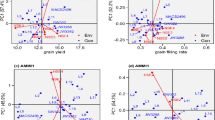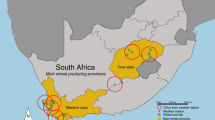Abstract
In cereal crops, environmental fluctuations affect different physiological processes during various developmental phases associated with the formation of yield components. Because these effects are coupled with cultivar-specific phenology, studies investigating environmental responses in different cultivars can give contradictory results regarding key phases impacting yield performance. To dissect how genotype-by-environment interactions affect grain yield in winter wheat, we estimated the sensitivities of yield components to variation in global radiation, temperature and precipitation in 220 cultivars across 81 time-windows ranging from double ridge to seed desiccation. Environmental sensitivity responses were prominent in the short-term physiological subphases of spike and kernel development, causing phenologically dependent, stage-specific genotype-by-environment interactions. Here we reconcile contradicting findings from previous studies and show previously undetected effects; for example, the positive impact of global radiation on kernel weight during canopy senescence. This deep insight into the three-way interactions between phenology, yield formation and environmental fluctuations provides comprehensive new information for breeding and modelling cereal crops.
This is a preview of subscription content, access via your institution
Access options
Access Nature and 54 other Nature Portfolio journals
Get Nature+, our best-value online-access subscription
$29.99 / 30 days
cancel any time
Subscribe to this journal
Receive 12 digital issues and online access to articles
$119.00 per year
only $9.92 per issue
Buy this article
- Purchase on Springer Link
- Instant access to full article PDF
Prices may be subject to local taxes which are calculated during checkout



Similar content being viewed by others
Data availability
The complete set of climate data and simulated soil data, yield components of all environments, and sensitivity and significance of yield components to all environmental variables of all genotypes and all time-windows are available in the Zenodo data repository54.
Code availability
No custom algorithm was used in this study. All code used to analyse the data is available from the authors. Please contact the first author or corresponding author (sabir@gem.uni-hannover.de or tsu-wei.chen@hu-berlin.de) in case of interest.
References
Wang, E. et al. The uncertainty of crop yield projections is reduced by improved temperature response functions. Nat. Plants 3, 17102 (2017).
Reynolds, M. et al. Raising yield potential in wheat. J. Exp. Bot. 60, 1899–1918 (2009).
Reynolds, M. et al. Achieving yield gains in wheat. Plant Cell Environ. 35, 1799–1823 (2012).
Raza, A. et al. Impact of climate change on crops adaptation and strategies to tackle its outcome: a review. Plants 8, 34 (2019).
Liu, B. et al. Global wheat production with 1.5 and 2.0 °C above pre-industrial warming. Glob. Chang. Biol. 25, 1428–1444 (2018).
Bönecke, E. et al. Decoupling of impact factors reveals the response of German winter wheat yields to climatic changes. Glob. Chang. Biol. 26, 3601–3626 (2020).
Mäkinen, H. et al. Sensitivity of European wheat to extreme weather. Field Crops Res. 222, 209–217 (2018).
Porter, J. R. & Semenov, M. A. Crop responses to climatic variation. Philos. Trans. R. Soc. Lond. B Biol. Sci. 360, 2021–2035 (2005).
Zhang, X. et al. Contribution of cultivar, fertilizer and weather to yield variation of winter wheat over three decades: a case study in the North China Plain. Eur. J. Agron. 50, 52–59 (2013).
Xu, J., Henry, A. & Sreenivasulu, N. Rice yield formation under high day and night temperatures – a prerequisite to ensure future food security. Plant Cell Environ. 43, 1595–1608 (2020).
Abbate, P. E., Andrade, F. H., Culot, J. P. & Bindraban, P. S. Grain yield in wheat: effects of radiation during spike growth period. Field Crops Res. 54, 245–257 (1997).
Fischer, R. A. Number of kernels in wheat crops and the influence of solar radiation and temperature. J. Agric. Sci. 105, 447–461 (1985).
Cossani, C. M. & Reynolds, M. P. Physiological traits for improving heat tolerance in wheat. Plant Physiol. 160, 1710–1718 (2012).
Wang, X. et al. Pre-anthesis high temperature acclimation alleviates the negative effects of post-anthesis heat stress on stem stored carbohydrates remobilization and grain starch accumulation in wheat. J. Cereal Sci. 55, 331–336 (2012).
Villegas, D. et al. Daylength, temperature and solar radiation effects on the phenology and yield formation of spring durum wheat. J. Agron. Crop Sci. 202, 203–216 (2016).
Guo, Z., Chen, D. & Schnurbusch, T. Plant and floret growth at distinct developmental stages during the stem elongation phase in wheat. Front. Plant Sci. 9, 330 (2018).
Lichthardt, C., Chen, T.-W., Stahl, A. & Stützel, H. Co-evolution of sink and source in the recent breeding history of winter wheat in Germany. Front. Plant Sci. 10, 1771 (2020).
Voss-Fels, K. P. et al. Breeding improves wheat productivity under contrasting agrochemical input levels. Nat. Plants 5, 706–714 (2019).
Wu, X., Tang, Y., Li, C. & Wu, C. Characterization of the rate and duration of grain filling in wheat in Southwestern China. Plant Prod. Sci. 21, 358–369 (2018).
Ferreira, M. S. et al. Physicochemical control of durum wheat grain filling and glutenin polymer assembly under different temperature regimes. J. Cereal Sci. 56, 58–66 (2012).
Guo, Z., Chen, D. & Schnurbusch, T. Variance components, heritability and correlation analysis of anther and ovary size during the floral development of bread wheat. J. Exp. Bot. 66, 3099–3111 (2015).
Guo, Z., Chen, D., Röder, M. S., Ganal, M. W. & Schnurbusch, T. Genetic dissection of pre-anthesis sub-phase durations during the reproductive spike development of wheat. Plant J. 95, 909–918 (2018).
Tardieu, F., Simonneau, T. & Muller, B. The physiological basis of drought tolerance in crop plants: a scenario-dependent probabilistic approach. Annu. Rev. Plant Biol. 69, 733–759 (2018).
Ji, H. et al. Effects of jointing and booting low temperature stresses on grain yield and yield components in wheat. Agric. For. Meteorol. 243, 33–42 (2017).
Fernández-Gómez, J., Talle, B., Tidy, A. C. & Wilson, Z. A. Accurate staging of reproduction development in Cadenza wheat by non-destructive spike analysis. J. Exp. Bot. 71, 3475–3484 (2020).
Fernández-Gómez, J., Talle, B. & Wilson, Z. A. Increased expression of the MALE STERILITY 1 transcription factor gene results in temperature-sensitive male sterility in barley. J. Exp. Bot. 71, 6328–6339 (2020).
Allen, D. J. & Ort, D. R. Impacts of chilling temperatures on photosynthesis in warm-climate plants. Trends Plant Sci. 6, 36–42 (2001).
Valluru, R., Link, J. & Claupein, W. Consequences of early chilling stress in two Triticum species: plastic responses and adaptive significance. Plant Biol. (Stuttg.) 14, 641–651 (2012).
González, F. G., Miralles, D. J. & Slafer, G. A. Wheat floret survival as related to pre-anthesis spike growth. J. Exp. Bot. 62, 4889–4901 (2011).
Reynolds, M. P., Acevedo, E., Sayre, K. D. & Fischer, R. A. Yield potential in modern wheat varieties: its association with a less competitive ideotype. Field Crops Res. 37, 149–160 (1994).
Narayanan, S., Prasad, P. V. V., Fritz, A. K., Boyle, D. L. & Gill, B. S. Impact of high night-time and high daytime temperature stress on winter wheat. J. Agron. Crop Sci. 201, 206–218 (2015).
Marcela, H. et al. Effect of heat stress at anthesis on yield formation in winter wheat. Plant Soil Environ. 63, 139–144 (2017).
Djanaguiraman, M., Narayanan, S., Erdayani, E. & Prasad, P. V. V. Effects of high temperature stress during anthesis and grain filling periods on photosynthesis, lipids and grain yield in wheat. BMC Plant Biol. 20, 268–280 (2020).
Wheeler, T. R. et al. The duration and rate of grain growth, and harvest index, of wheat (Triticum aestivum L.) in response to temperature and CO2. J. Exp. Bot. 47, 623–630 (1996).
Distelfeld, A., Avni, R. & Fischer, A. M. Senescence, nutrient remobilization, and yield in wheat and barley. J. Exp. Bot. 65, 3783–3798 (2014).
Fahy, B. et al. Final grain weight is not limited by the activity of key starch-synthesising enzymes during grain filling in wheat. J. Exp. Bot. 69, 5461–5475 (2018).
Ugarte, C., Calderini, D. F. & Slafer, G. A. Grain weight and grain number responsiveness to pre-anthesis temperature in wheat, barley and triticale. Field Crops Res. 100, 240–248 (2007).
Sinclair, T. R. & Jamieson, P. D. Grain number, wheat yield, and bottling beer: an analysis. Field Crops Res. 98, 60–67 (2006).
Ma, Y.-Z., MacKown, C. T. & van Sanford, D. A. Sink manipulation in wheat: compensatory changes in kernel size. Crop Sci. 30, 1099–1105 (1990).
Neukam, D., Ahrends, H., Luig, A., Manderscheid, R. & Kage, H. Integrating wheat canopy temperatures in crop system models. Agronomy 6, 7 (2016).
Kage, H. & Stützel, H. In Modelling Cropping Systems (eds Donatelli, M. et al.) 299–300 (European Society of Agronomy, 1999).
Marti, J., Savin, R. & Slafer, G. A. Wheat yield as affected by length of exposure to waterlogging during stem elongation. J. Agron. Crop Sci. 201, 473–486 (2015).
Xie, Q., Mayes, S. & Sparkes, D. L. Carpel size, grain filling, and morphology determine individual grain weight in wheat. J. Exp. Bot. 66, 6715–6730 (2015).
Tomás, D., Rodrigues, J. C., Viegas, W. & Silva, M. Assessment of high temperature effects on grain yield and composition in bread wheat commercial varieties. Agronomy 10, 499 (2020).
Fischer, R. A. & Maurer, O. R. Crop temperature modification and yield potential in a dwarf spring wheat. Crop Sci. 16, 855–859 (1976).
Hatfield, J. L. & Walthall, C. L. Meeting global food needs: realizing the potential via genetics × environment × management interactions. J. Agron. 107, 1215–1226 (2015).
Russell, K., Lee, C. & van Sanford, D. Interaction of genetics, environment, and management in determining soft red winter wheat yields. J. Agron. 109, 2463–2473 (2017).
Millet, E. J. et al. Genomic prediction of maize yield across European environmental conditions. Nat. Genet. 51, 952–956 (2019).
Parent, B., Millet, E. J. & Tardieu, F. The use of thermal time in plant studies has a sound theoretical basis provided that confounding effects are avoided. J. Exp. Bot. 70, 2359–2370 (2019).
Arnold, P. A., Kruuk, L. E. B. & Nicotra, A. B. How to analyse plant phenotypic plasticity in response to a changing climate. New Phytol. 222, 1235–1241 (2019).
Kahlen, K. & Stützel, H. Modelling photo-modulated internode elongation in growing glasshouse cucumber canopies. New Phytol. 190, 697–708 (2011).
Kahlen, K. & Chen, T.-W. Predicting plant performance under simultaneously changing environmental conditions – the interplay between temperature, light, and internode growth. Front. Plant Sci. 6, 1130 (2015).
R Core Team. R: A language and environment for statistical computing (R Foundation for Statistical Computing, 2014).
Sabir, K. et al. Stage-specific genotype-by-environment interactions determine yield components in wheat [Data set]. Zenodo https://doi.org/10.5281/zenodo.8248543 (2023).
Acknowledgements
Funding for this study was provided by the German Federal Ministry of Education and Research grant no. 031A354. T.-W.C. was funded by Deutsche Forschungsgemeinschaft (German Research Foundation) under project no. 442020478.
Author information
Authors and Affiliations
Contributions
T.-W.C. conceived the analyses. K.S. and T.-W.C. analysed the data. T.R. simulated the soil water content. B.W., A.S. and R.J.S. designed the experiments. T.-W.C., T.R., H.Z., A.B., F.O., J.L., H.K., H.S. and W.F. performed and supervised the experiments and provided data. K.S., H.S. and T.-W.C. wrote the paper.
Corresponding author
Ethics declarations
Competing interests
The authors declare no competing interests.
Peer review
Peer review information
Nature Plants thanks Enli Wang, Juan Burgueño and the other, anonymous, reviewer(s) for their contribution to the peer review of this work.
Additional information
Publisher’s note Springer Nature remains neutral with regard to jurisdictional claims in published maps and institutional affiliations.
Supplementary information
Supplementary Information
Supplementary Figs. 1–11, Tables 1–6 and Method.
Rights and permissions
Springer Nature or its licensor (e.g. a society or other partner) holds exclusive rights to this article under a publishing agreement with the author(s) or other rightsholder(s); author self-archiving of the accepted manuscript version of this article is solely governed by the terms of such publishing agreement and applicable law.
About this article
Cite this article
Sabir, K., Rose, T., Wittkop, B. et al. Stage-specific genotype-by-environment interactions determine yield components in wheat. Nat. Plants 9, 1688–1696 (2023). https://doi.org/10.1038/s41477-023-01516-8
Received:
Accepted:
Published:
Issue Date:
DOI: https://doi.org/10.1038/s41477-023-01516-8



